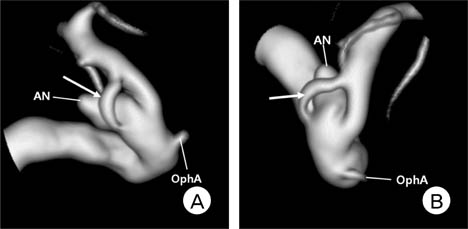J Cerebrovasc Endovasc Neurosurg.
2012 Dec;14(4):295-299. 10.7461/jcen.2012.14.4.295.
Supraclinoid Internal Carotid Artery Fenestration Harboring an Unruptured Aneurysm and Another Remote Ruptured Aneurysm: Case Report and Review of the Literature
- Affiliations
-
- 1Department of Neurosurgery, Keimyung University School of Medicine, Daegu, Korea. nslcy@dsmc.or.kr
- KMID: 1431283
- DOI: http://doi.org/10.7461/jcen.2012.14.4.295
Abstract
- A fenestration of the supraclinoid internal carotid artery (ICA) is a rare congenital condition. We report an aneurysm arising from the proximal end of an ICA fenestration that was treated by endovascular coiling. Three-dimensional rotational angiography of preoperative cerebral angiography provided an understanding of the complex anatomy of the aneurysms associated with the fenestration and may facilitate the clinical decision regarding the treatment option. Endovascular coiling appears to be safe and effective for treating an aneurysm originating from a fenestration on the supraclinoid ICA, which is a difficult lesion to treat using a conventional surgical approach.
Figure
Reference
-
1. Ahn JH, Kim MS, Lee HK, Lee SJ, Park HI, Lee CH. Fenestration and duplication of the vertebrobasilar artery detected by conventional angiography and magnetic resonance angiography. J Korean Neurosurg Soc. 2006. 05. 39(5):355–359.2. Banach MJ, Flamm ES. Supraclinoid internal carotid artery fenestration with an associated aneurysm. Case report. J Neurosurg. 1993. 09. 79(3):438–441.3. Bharatha A, Fox AJ, Aviv RI, Symons SP. CT angiographic depiction of a supraclinoid ICA fenestration mimicking aneurysm, confirmed with catheter angiography. Surg Radiol Anat. 2007. 06. 29(4):317–321.
Article4. Black SP, Ansbacher LE. Saccular aneurysm associated with segmental duplication of the basilar artery. A morphological study. J Neurosurg. 1984. 12. 61(6):1005–1008.5. Chen YY, Chang FC, Hu HH, Chao AC. Fenestration of the supraclinoid internal carotid artery associated with aneurysm and ischemic stroke. Surg Neurol. 2007. 68:Suppl 1. (1):S60–S63. discussion S63.
Article6. Dey M, Awad IA. Fenestration of supraclinoid internal carotid artery and associated aneurysm: embryogenesis, recognition, and management. World Neurosurg. 2011. 12. 76(6):592.e1–592.e5.
Article7. Findlay JM, Chui M, Muller PJ. Fenestration of the supraclinoid internal carotid artery. Can J Neurol Sci. 1987. 05. 14(2):159–161.
Article8. Hattori T, Kobayashi H. Fenestration of the supraclinoid internal carotid artery associated with carotid bifurcation aneurysm. Surg Neurol. 1992. 04. 37(4):284–288.
Article9. Ichikawa T, Miyachi S, Izumi T, Matsubara N, Naito T, Haraguchi K, et al. Fenestration of a supraclinoid internal carotid artery associated with dual aneurysms: case report. Neurosurgery. 2011. 10. 69(4):E1005–E1008. discussion E1009.
Article10. Katsuta T, Matsubara T, Fujii K. Fenestration of the supraclinoid internal carotid artery. Neuroradiology. 1993. 35(6):461.
Article11. Lasjaunias P, Santoyo-Vazquez A. Segmental agenesis of the internal carotid artery: angiographic aspects with embryological discussion. Anat Clin. 1984. 6(2):133–141.
Article12. Nakiri GS, Bravo E, Al-Khawaldeh M, Rivera R, Badilla L, Mounayer C. Endovascular treatment of aneurysm arising from fenestration of the supraclinoid internal carotid artery-two case reports. J Neuroradiol. 2012. 07. 39(3):195–199.13. Ng PP, Steinfort B, Stoodley MA. Internal carotid artery fenestration with dual aneurysms. Case illustration. J Neurosurg. 2006. 06. 104(6):979.14. Onoda K, Ono S, Tokunaga K, Sugiu K, Date I. Fenestration of the supraclinoid internal carotid artery with associated aneurysm. Neurol Med Chir (Tokyo). 2008. 03. 48(3):118–120.15. Plumb AA, Herwadkar A, Pickett G. Incidental finding of fenestration of the supraclinoid internal carotid artery with appearances on magnetic resonance angiography. Surg Radiol Anat. 2010. 02. 32(2):165–169.
Article16. Sanders WP, Sorek PA, Mehta BA. Fenestration of intracranial arteries with special attention to associated aneurysms and other anomalies. AJNR Am J Neuroradiol. 1993. May-Jun. 14(3):675–680.17. Takano S, Saitoh M, Miyasaka Y, Yada K, Takagi H. Fenestration of the intracranial internal carotid artery-case report. Neurol Med Chir (Tokyo). 991. 11. 31(11):740–742.18. Teal JS, Rumbaugh CL, Bergeron RT, Segall HD. Angiographic demonstration of fenestrations of the intradural intracranial arteries. Radiology. 1973. 01. 106(1):123–126.
Article19. van Rooij SB, van Rooij WJ, Sluzewski M, Sprengers ME. Fenestrations of intracranial arteries detected with 3D rotational angiography. AJNR Am J Neuroradiol. 2009. 08. 30(7):1347–1350.
Article20. Yock DH Jr. Fenestration of the supraclinoid internal carotid artery with rupture of associated aneurysm. AJNR Am J Neuroradiol. 1984. Sep-Oct. 5(5):634–636.
- Full Text Links
- Actions
-
Cited
- CITED
-
- Close
- Share
- Similar articles
-
- Cerebral Aneurysm in the Long Fenestration at the Middle Portion of M1 Segment
- M1 Fenestration in a Patient with Multiple Cerebral Arterial Aneurysms: Case Report
- Ruptured Aneurysm Arising from a Fenestrated A1 Segment of the Anterior Cerebral Artery
- Postoperative Vasospasm in Unruptured Intracranial Aneurysm
- Ruptured proximal anterior cerebral artery (A1) aneurysm located at an anomalous branching of the fronto-orbital artery--a case report




